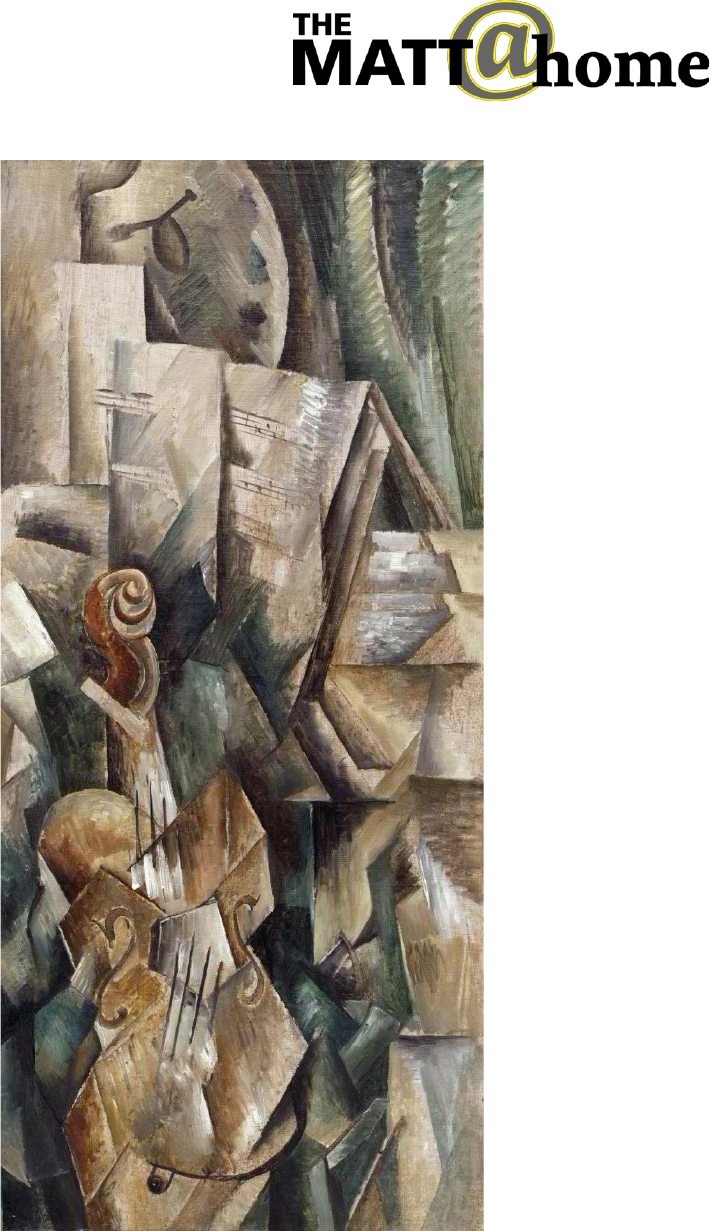
George L.K. Morris and Cubism Lesson Plan
Learn more: mattmuseum.org/the-matt-at-home/ Page 1
George L.K. Morris
Who was George L.K. Morris and what is Cubism?
Duration: 45 minutes
Grade Level: Grades 2 – 8
Learning Objectives:
• Learn about the life of George L.K. Morris
• Study what the art movement Cubism is
• Learn what influences an artist’s work
Outcomes:
• Students will learn about Cubism and its two distinct movements
• Students will study how relationships and life experience influenced an
artist’s work
• Students will engage in critical thinking and visual skills by analyzing
artwork
Associated Activities:
• Cubism Coloring Pages, 30 minutes
• Recycled Robot, 45 minutes

George L.K. Morris and Cubism Lesson Plan
Learn more: mattmuseum.org/the-matt-at-home/ Page 2
Who was George L.K. Morris?
Morris was born in New York City on
November 14, 1905. Morris attended Groton
School, and then graduated from Yale
University in 1928. From 1928 to 1929, he
studied Realism at the Art Students League of
New York under painters John French Sloan
and Kenneth Hayes Miller. In 1929, he traveled
to Paris, where he continued his studies with
Fernand Léger and Amédée Ozenfant. It was
there that he became a confirmed
abstractionist.
In 1935, he married fellow artist, Suzy Frelinghuysen. In 1936, he became one of
the founding members of the American Abstract Artists and served as its
president in the 1940s. He and his wife were part of the Park Avenue Cubists, a
group of four artists who came from affluent backgrounds. Morris is best known
for his Cubist sculptures and paintings.
Courtesy Frelinghuysen Morris House & Studio

George L.K. Morris and Cubism Lesson Plan
Learn more: mattmuseum.org/the-matt-at-home/ Page 3
What is Cubism?
Cubism was started in the early 20
th
century by Pablo Picasso and Georges
Braque. The artworks are geometrical and look like they are made of cubes, thus
giving the movement its name. There are two types of cubism: analytical and
synthetic. Analytical cubism is characterized by monochrome (one color)
artworks, and the focus was showing different angles of a subject in one
artwork. Synthetic cubism brought in brighter colors and collages. Cubism also
included sculpture and architecture designed based on cubist principles.
Activity: Color your own Cubist art with our Cubism Coloring Pages.
Pablo Picasso, Girl with a Mandolin (Fanny
Tellier), 1910, oil on canvas, Museum of
Modern Art, New York
Juan Gris, Violin and Checkerboard, 1913,
Oil on canvas, private collection

George L.K. Morris and Cubism Lesson Plan
Learn more: mattmuseum.org/the-matt-at-home/ Page 4
George L.K. Morris and His Art
George L.K. Morris was not just a painter – he was also a sculptor, writer, and
editor. When he first began his art career, he studied realist art, but his journey
to Paris would change his focus to abstract art. From 1937 through 1943, Morris
advocated for abstract art while editor, art critic, and patron of the literary
magazine Partisan Review. After 1947, he wrote less and focused primarily on
painting and sculpture.
Did you know? Munitions is a term used to describe materials for war like
ammunition and equipment.
George L.K. Morris, Munition Factory,
1943, oil on canvas, Art Bridges

George L.K. Morris and Cubism Lesson Plan
Learn more: mattmuseum.org/the-matt-at-home/ Page 5
Art Analysis
What do you think the following artworks represent? People? Instruments?
Other objects? Which ones do you think are analytical cubism and which are
synthetic cubism?
Juan Gris, Violin and Playing Cards on a Table, 1913,
oil on canvas, Metropolitan Museum of Art

George L.K. Morris and Cubism Lesson Plan
Learn more: mattmuseum.org/the-matt-at-home/ Page 6
Pablo Picasso, Three Musicians, 1921, oil on canvas,
Museum of Modern Art
Pablo Picasso, Guernica, 1937, oil on canvas, Museo Reina Sofía

George L.K. Morris and Cubism Lesson Plan
Learn more: mattmuseum.org/the-matt-at-home/ Page 7
Georges Braque, Violin and Palette, 1909, oil on
canvas, Solomon R. Guggenheim Museum

George L.K. Morris and Cubism Lesson Plan
Learn more: mattmuseum.org/the-matt-at-home/ Page 8
George L. K. Morris, Taurus, 1965, marble,
Smithsonian American Art Museum
Activity: Create 3D Cubist robots using found objects at home with our
Recycled Robot activity.
